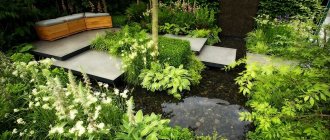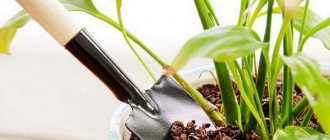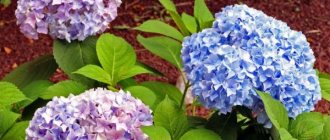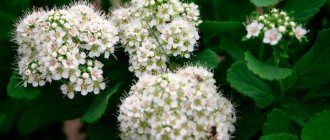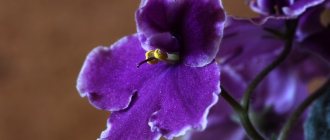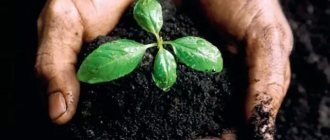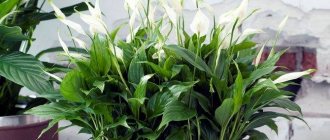Indoor flowers that love moisture take root well in city apartments. These are mainly plants from the swamps of Africa and the Amazon. Although it is hot in these tropical wilds, the undergrowth where the moisture-loving guests originally survived receives almost no sun. In such swamps there is even less light than in city apartments in winter. To choose a flower for yourself, you need to at least know the main types of moisture-loving indoor plants.
Transpiration
Most often, gardeners in their dachas remove excess water, of course, using a drainage system. Some trees can be a great addition to it. Such plants draw water from the ground, drying it out. This process is called transpiration.
By transpiring water through their roots, trunk and branches, trees evaporate it through their leaves. This process is useful for the plant in that it cools its parts in the heat. Each plant has its own indicators of water extraction and evaporation. This figure can be 10-600 liters per day.
One tree or bush can drain the ground within a radius of 7-12 meters around the trunk. The root system of such plants literally works like a pump.
Planting trees for drainage - biodrainage
The method of reducing groundwater levels and draining areas using green spaces - biological drainage - has been known for many years. This is possible thanks to transpiration - the ability of plants to absorb water through their roots and evaporate it through their stems and leaves.
Transpiration of water by trees.
For example, during the Soviet Union, areas with high groundwater levels were massively planted with poplars, and one adult poplar can suck up to 800 liters of water per day from the ground and evaporate. This made it possible to significantly lower the water level in the ground and help keep the foundations and basements of houses dry. And it would be stupid not to use these properties of trees now when using cesspools.
Row of pyramidal poplars.
Simple mathematics: on average, in a private house, 1 person uses about 200 liters of water per day, a family of 4 people uses 800 liters. That is, if you plant a tree, for example, a poplar, next to the cesspool, when it grows, it can completely solve the problem of wastewater disposal on the site. However, few people decide to plant a poplar near their house. The tree will grow huge, the neighbors will obviously not be happy, and when the time comes and it needs to be cut down, this will result in a serious problem. Not to mention the poplar fluff.
Requirements for plants for waterlogged areas
The main requirements for such plants are a love for a high level of moisture and a fear of flooding and stagnation of moisture in the soil. They must be able to withstand low oxygen concentrations in the soil and be able to withstand flooding and getting wet. But sufficient endurance and resistance to frost are equally important. After all, soil saturated with moisture creates specific and more severe conditions, freezing earlier than ordinary garden soil, and thawing much later.
Lysichiton in the design of a waterlogged area. © Kathryn Mezger
Crops that can settle in waterlogged, swampy areas in the garden are very different. They are conventionally divided into:
- decorative deciduous, the flowering of which is rather inconspicuous;
- beautifully flowering (but their foliage is also always quite attractive).
You can find your moisture-loving stars among perennials and even among annuals. But most crops are still classified either as giants (trees and shrubs from viburnum to hydrangea and maples), or as herbaceous perennials that will decorate such areas for decades.
Plants that can grow in damp areas are suitable for decorating various water bodies and prefer to settle in shallow water or in swamps. But there are also plants that are more often used in decorative swamps or wet flower beds, and not in reservoirs. Wet flower beds, although rare, are becoming increasingly widespread and help solve problems without drastic measures and significant funds.
Buzulnik
Buzulnik will delight you with beautiful leaves (purple on the underside) and decorative yellow-orange flowers. Blooms in summer and until late autumn. Loves places in partial shade and even shade, and also needs constantly moist soil. It can even grow on the banks of water bodies.
This magnificent plant grows up to 1-1.5m in height and the leaves form large, spreading clumps, so it needs to be given plenty of space when planting. Overwinters without problems.
What fruit plants are best to plant in the garden to drain the soil?
There is only one contender here - the plum. Despite this, plum has so many subspecies that you can easily choose the one that is suitable for your garden. Do not forget that the main thing is not the variety or variety of plum, but the rootstock on which it is grafted. It is the roots that grow in the soil and respond to it. But since an ordinary gardener who purchases plants in a nursery, and most often from hand, does not have the opportunity to influence the rootstock, we will do it simpler. Just believe my experience and take it as faith that renklads drain the soil best, but they are also more demanding of the soil, so you will achieve successful growth and abundant fruiting of plums by planting them using the technology described above.
Damsons.
But the least worries and a wonderful harvest of fruits are produced by damsons. There are also a huge number of varieties; the trees are compact and can be planted three meters apart. At the same time, damson plums practically do not suffer from pests, unlike ordinary plums. And of course, cherry plum is suitable for very lazy summer residents. Its modern species have quite large and tasty fruits, unlike those that we are used to seeing everywhere.
And now about the best plants, about which in Rus' they make up fairy tales and sing songs. Weeping willow. It is suitable for any site, be it a garden, cottage or personal plot. The weeping willow can look like a tree or shrub and has more than 600 species and varieties. Some varieties of willow, under certain conditions, grow to a height of only 20 cm. That is why weeping willow is considered the best of the plants that help drain the soil and at the same time it easily fits into any landscape project.
Features of crops for wet soil
Moisture-loving trees and shrubs for the garden are a real boon for areas with damp soil.
You can plant them in arid climates, but in this case you will have to independently provide them with the necessary conditions for growth and development. There are 2 types of moisture-loving plants:
- With beautiful leaves and flowers.
- Deciduous, with unattractive flowers.
These types of plants can be annual or perennial.
Most of them are shrubs and trees, for example, hydrangea, viburnum or herbaceous crops, which grow in one place for a long time. Their natural environment is marshy or watery areas. Such specimens can be safely grown under artificial conditions. The peculiarity of moisture-loving plants is that they absorb water around them, drying the soil. Birch can remove excess moisture at a distance of up to 10 meters around itself. This feature is characteristic of willow, elderberry and maple. Cranberries, silver currants, and viburnum are also moisture-loving shrubs. You can plant several fruit-bearing bushes on the site, but you should know that moisture-resistant vegetation does not bear fruit on waterlogged soil.
Variety of moisture-loving flowers, shrubs, trees
Birch is fluffy.
If you have a personal plot, the ideal water source for it is downy birch. A couple or three trees planted in the lower part of the site or the water drainage point on the site and the problem with flooding from spring to autumn will be solved. Despite the fact that the birch root system is very developed, the roots do not penetrate deep into the soil, so the trees can be subject to wind blows. Downy birch is the most cold-resistant of the birches. Please note that this is the second time in the article that I have mentioned local drainage; if general drainage cannot be done, or it is not possible to drain groundwater outside the site, the site must still be planned with a slight slope and local drainage must be installed at the lowest point. And in the place planned for planting plants that will help you drain the soil, build a drainage well; its optimal dimensions are 3x3 meters. It would be even better if there were several such wells, they would be connected by a system of pipes and a tree would be planted near each one.
Pits for planting trees to drain the site also need to be prepared somewhat differently than for regular planting. As I already mentioned, the root system of trees for draining the site is very well developed and lies at a depth of 60-80 cm. In this regard, the planting pit for plants used in draining the site should be meter by meter in size and also at least 0.8 meters deep . The lower part of the planting hole should be filled 50 centimeters with a large stone, the simplest and cheapest option is plaster mixed with soil; the stone (not brick) will support the roots and create additional drainage. This method of planting trees used to drain the site should be followed for any plants.
Red maple.
To drain and at the same time decorate a personal plot, alder, larch, ash and Tatar maple are also used in landscape design. A separate page is dedicated to each of these plants on the site; you can go to it by clicking on the corresponding highlighted word. I will dwell in more detail only on the ash tree at the end of the article; I have a separate story connected with it with landscape design.
Irga
It is not for nothing that this unpretentious plant is considered unique. Irga can be planted somewhere in a corner of the garden - and it will feel great.
The shrub's ability to absorb large amounts of water from the soil has made it the most desirable crop for owners of damp summer cottages.
The roots of the serviceberry reach 2 m in depth and cover 2.5 m in circumference. By the way, this helps it survive: tolerate shading, gas pollution, drought and grow quickly.
In the spring, the serviceberry blooms beautifully, in the fall it pleases with bright foliage, and in the summer with sweet berries. In addition, it is durable - some specimens grow in front gardens for up to 60 years.
Popular varieties of serviceberry:
- Irga Krasnoyarskaya is a fruit and ornamental plant, a shrub of the Rosaceae family, and an excellent honey plant. The stems of the serviceberry are raised, long - up to 3.5 meters, red-gray with large green leaves. The fruit is a berry 1 cm in diameter, with purple skin and juicy, fragrant, aromatic pulp.
- Irga Brilliant is a late-ripening, high-yielding variety. The berries have a special taste; they are completely sweet, without acid. This is a great summer treat for children and adults.
- Irga Northline is a representative of fast-growing, winter-hardy and productive varieties. The useful plant resists diseases. It begins to bear fruit 3-4 years after planting. It blooms on warm May days, fruit ripening begins in July-August. The bushes are tall, can reach 4 m in height. The crown is round in shape and can reach 6 m in diameter.
- Irga Aroma Fruit - The sweet, raisin taste of the berries is pleasant and harmonious, and their color changes as they ripen, smoothly transitioning from bright pink to dark purple.
Plum
For those who want to drain the area and get a wonderful harvest of ripe berries as a bonus, we can recommend planting plums in their dacha.
Moreover, when buying a seedling in a nursery or on the market, you need to pay attention to the rootstock. After all, it is the roots of the plant that must penetrate deep into the soil and take excess water from it.
Experts advise purchasing recyclables. This subspecies of plum will drain the area as quickly and without problems as possible.
You need to plant a tree using a certain technology. Drainage must be placed in the hole. Sufficiently large stones that need to be mixed with soil are suitable. The depth of the planting hole must be at least 80 cm.
Popular plum varieties:
- Honey plum does not have a thick crown. The variety is self-sterile, so to increase productivity it is necessary to plant plum trees of other varieties nearby (the Hungarian variety is a good pollinator). The fruits ripen early and have a regular round shape. The aromatic pulp has a delicious taste, the skin is yellow with a waxy coating, at the same time tender and durable.
- Blue Free Plum - Light purple with a bluish bloom, Blue Free plums have an amazing taste and bright aroma. The tree has a spreading, wide crown, which is not particularly dense. The ripened harvest is clearly visible between the leaves, and plums are easy to pick.
- Delicacy plum is a tasty and large fruit that ripens in late summer or early autumn. The fruit has a round shape, the skin is purple with a delicate waxy coating. The yellow flesh has a sweet taste and does not stick to the small seed.
- Ruby is a low compact tree reaching a height of up to 2 m. The crown is narrow, the crop ripens on short fruit branches growing directly from the main trunk.
- Blue Sweet is a variety of fruit tree with a small trunk and a pyramidal crown. It is characterized by weak formation of lateral branches and high yield. The fruits are blue, with a characteristic waxy coating, the flesh is juicy and yellow. The variety is cold-resistant - it overwinters in the middle zone without additional shelter. Self-sterile, Blue Free plum variety is suitable for cross-pollination.
Mock orange (garden jasmine)
This perennial plant, sometimes called jasmine, needs sufficient moisture. This is very useful for a gardener - in addition to draining the area, mock orange will fit perfectly into any landscape, enriching it with new colors.
Garden jasmine blooms charmingly - in summer its inflorescences of white or cream shades decorate hedges and form an excellent composition with annuals and ornamental shrubs.
It is better to place the mock orange in a sunny area. The soil for this crop must be fertile. The seating area is prepared 2 weeks in advance. It is advisable to lay crushed stone at the bottom of the hole, and above it - leaf soil with humus.
Popular varieties of garden jasmine:
- Mock orange (Jasmine) Snowfall is a luxurious shrub that exudes an intoxicating sweet aroma during flowering. In June, the tall bush puts on an alabaster headdress of thousands of flowers, which cover the plant like an openwork snow blanket.
- Mock orange (jasmine) Mont Blanc is a stylish shrub from the Hydrangeaceae family. With sufficient lighting, it grows in width and does not exceed the mark of two meters in height. During flowering, which occurs in mid-summer, the variety is fabulously good!
- Mock orange (jasmine) Yellow Hill is more charming than the classic specimens of its species due to the abundance of double flowers. Each of the opened buds captivates with its pristine whiteness, the refinement of the lines of the petals and a wonderful, well-recognized aroma.
Catchment (aquilegia)
The name of the flower speaks for itself: aquilegia consumes a fair amount of moisture every day, thereby drying out the soil. The catchment can be placed in a sunny or shaded place.
It is better to prepare seedlings at home, and then plant them in a flowerbed or lawn at the beginning of summer. In the first year the bushes will not bloom, but then the plants will feel at ease and begin to actively grow.
If you plant aquilegia under fruit trees, which also consume a lot of water, you will get a whole complex for draining the garden plot. And the flowering of the catchment in the lace shade will be longer and more abundant.
Popular varieties of aquilegia:
- Aquilegia Altai Giant (catchment) is an unusual perennial herbaceous plant from the Ranunculaceae family. It is characterized by a wide variety of colors of rather large delicate flowers and their very unusual shape.
- Aquilegia Tower dark blue is an ornamental perennial shrub, a representative of the Ranunculaceae family. Grows up to 70 cm. The bush is distinguished by its spreading habit and bluish-green trifoliate leaves. The flowers are 4-5 cm in diameter, double, deep blue.
- Aquilegia Tower pink is a luxurious, densely double perennial, one of the most beautiful in its variety group. Tall branched bushes with strong peduncles reach a height of 70 cm. The inflorescences, consisting of several dense tiers, have an excellent shape and short spurs, which indicates the European origin of the cultivar. The diameter of the flower is 5 centimeters.
- Aquilegia Winky Double Purple - the plant is called the elf flower for the beautiful shape and color of the flowers with a diameter of 4-6 cm. The fabulous buds of this variety are distinguished by the lilac-purple color of the petals with a white tint at the edges. A large number of flowers gradually bloom on one peduncle about 80 cm high.
- Aquilegia Blue Star is an elegant perennial shrub with lacy foliage and large blue flowers. The five-pointed flower reaches 5 cm in diameter. The bush grows in one place for 3-5 years and combines well with other plants.
Weeping willow
Fairy tales and poems were often written about this plant in Rus'. Various types of willows love moist areas and are excellent for garden plots. Garden willow, which can be found not only in gardens, but also in city squares - Tristis, has picturesque hanging shoots, but quickly grows to impressive sizes and is therefore appropriate only in spacious gardens.
In a small dacha it is better to grow low varieties, for example, purple willow Nana or Pendula.
According to gardeners, weeping willow is considered an effective plant that helps drain the soil. It is easy to fit into any landscape project.
Red maple
This unpretentious tree has been used in landscape design for a long time. Many varieties of maple varieties allow you to choose the most suitable one for your site. Red maple is good for waterlogged soils - up to 15 m high, with a spreading, picturesque crown. It blooms in March-April, has reddish leaves that turn green in summer.
Prefers sun, but is considered shade-tolerant. It is not afraid of wind, smoke and gases, so it is grown even in cities. It does not like alkalization, but it grows well in moist and loamy soils, absorbing excess water. Beautiful both in a group and alone.
Gray alder
Gray alder Pendula tolerates marshy soil well. Grows up to 6 meters in both height and width. Perfectly suited for spacious areas with a pond: branches falling towards the water look very picturesque.
But more compact varieties are suitable for growing in small front gardens. These include bush-shaped alder Aurea with a conical crown and Laciniata with openwork leaves.
Chokeberry and viburnum
These plants are not only picturesque, but also help to slightly reduce the water level in flooded garden areas. They have an intense metabolism and fairly wide leaves, and their dense root system is close to the surface of the earth.
Chokeberry or chokeberry is used for planting hedges and strengthening ravines. Prefers moist loamy soils and plenty of sun. Produces tart, juicy berries. Another shrub that loves water is viburnum. It is shade-tolerant and produces healthy fruits in the form of red berries, from which compotes and jams are made.
Metasequoia is the oldest
Most conifers do not tolerate flooded areas well, but there is an unusual tree that grows well in damp places - the relict metasequoia. It is successfully grown in open ground all the way to St. Petersburg, where it tolerates long-term frosts. In its native China, metasequoia grows around flooded rice fields. It easily tolerates high groundwater levels.
Loves light and does not tolerate drafts. Suitable for creating oriental style gardens and for framing water features.
The most effective solution for draining garden soil is drainage, and plants only serve as a supplement. After planting them, the water balance will change over time, and the process of selecting plantings will become more flexible - you can plant other bushes and trees you like.
Swamp Rose
Swamp rose is an erect, spreading bush up to two meters high. It constantly produces young shoots and grows quickly. This shrub is also known as Pennsylvania rose. It comes from North America. It lives on the shores of reservoirs and in wetlands, as well as in ravines. Prefers partial shade and bright sunlight. The purple-reddish shoots have many thorns, and the edges of the pubescent dark foliage have teeth. The appearance of a picturesque openwork crown is complemented by inflorescences of several small flowers. The bush emits a pleasant aroma. During the summer, the color changes from pink to bright orange. Flowering occurs in July-August.
Swamp rose requires constant care, including timely removal of young shoots and annual pruning of old branches. This crop is suitable for creating a spectacular accent. It stands out brightly against the background of decorative foliage plants.
Himalayan honeysuckle
Himalayan honeysuckle is one of the moisture-loving shrubs that do not require special care and are very easy to grow. This plant looks very impressive near a pond, when its arched green branches covered with purple flowers bend over the surface of the water. The best background for growing Himalayan honeysuckle is white turf.
Cherry plum
The group of fruit plants that evaporate large amounts of moisture also includes cherry plum. This is not surprising, because the culture is a relative of the plum. The amount of moisture absorbed depends on the size of the tree and can reach up to 200 liters per day if we are talking about 10-meter specimens. More often, low-growing varieties are grown in gardens; their ability to transpirate is more modest.
Cherry plum is highly productive. A bush or tree begins to bear fruit the very next year after planting. At the age of ten, one specimen can produce up to 300 kg of fruit. The taste of cherry plum fruits is inferior to plums, but they have a rich composition. They contain biologically active substances, large amounts of vitamins A and C, potassium, and iron.
Norway maple
Norway maple is considered a fairly powerful pump tree. It sucks up to 250 liters of water from the soil per day. A deciduous tree looks especially impressive in autumn, when its foliage combines red, orange, and yellow colors.
The maple evaporates a large amount of moisture thanks to its wide, dense spherical crown. The characteristics of a tree depend on its variety. For example, the Crimson King maple has purple foliage in summer, but by autumn the leaves turn purple.
Nature wisely regulates various processes that man can use to his advantage. Planting dehumidifier trees at your dacha will allow you to get rid of not only frequent calls to the sewer service, but also the accumulation of moisture on the site during rain or melting snow. Some crops will additionally give summer residents a generous harvest, while others will delight them with decorative qualities.
Bird cherry
In the wild, bird cherry often grows near bodies of water, which indicates the plant’s high need for moisture. Depending on its growth and age, a tree can evaporate from 150 to 250 liters of water per day. Some varieties of bird cherry grow as a bush.
This crop is popularly nicknamed the bride for its impressive flowering and pleasant aroma that spreads over long distances. The tree gives rapid growth - 50-70 cm per year. Bird cherry begins to bear fruit at 5-6 years of age. The plant is very hardy and requires virtually no care.
Loosestrife
Loosestrife is a perennial plant with straight shoots that form clumps 70-80 centimeters high. This culture is shade-tolerant, but loves sunlight, in which it quickly grows into a large bush, or more precisely, into a clump. Loosestrife tolerates harsh winters well and does not need shelter during the cold season. It has a powerful but shallow root system that tends to cover a large area. For this reason, to preserve the beauty of the flower garden, it is necessary to regularly remove excess parts of the bush. When growing creeping varieties, it is necessary to control their growth; when growing erect varieties, remove the inflorescences and hill them up.
The best conditions for growing loosestrife are moderately humid, although it does well in waterlogged areas. Loosestrife blooms from May to August. At this time, white, pale yellow or pink inflorescences bloom. After flowering is completed, the faded parts are cut off, due to which re-blooming begins, which is more abundant.
Thyroid darmera
Thyroid darmera is a herbaceous perennial plant with huge leaves. It tolerates cold well in winter. Darmera does not shoot underground shoots; the bush grows evenly. The knobby, powerful, thick rhizome of the plant has a diameter of 6 centimeters.
With the help of this crop, the coasts of reservoirs and large wetlands are decorated; it is used for arranging damp flower beds. Green leaves with veins and grooves are perfect for this purpose. Throughout the season, streaks and purple spots appear on them. Flowering occurs in April-May, before the leaves appear. The beauty of delicate pink flowers is emphasized by unusual purple stems. The best soil for dharmera is one with variable levels of swampiness. She doesn't really like sunlight and prefers partial shade. If the bush grows excessively, it is divided. It is recommended to trim the flower stalks. Fertilizing is done every spring. The most common variety “Nanum” has a height of up to 50 centimeters.
Swamp calamus
Under natural conditions, marsh calamus grows near lakes, rivers and swamps. Gardeners also plant it in their summer cottages. This hardy plant has long, bright green leaves with frilled edges. It looks great in wetlands. Calamus loves sunny open areas with fertile, silty, floodable soil. It requires early flowering neighbors who close the clumps in early summer.
This crop needs to be constantly weeded; if it grows excessively, the clumps must be separated. The most popular variety at present is not the marsh calamus, but the garden variety of this plant with white and cream stripes, called “Variegata”. Its striking coloring and relatively low height form a pleasant background and make a strong impression thanks to its unusual appearance.
Swamp spurge
The Euphorbiaceae family includes herbaceous plants, subshrubs, shrubs and trees. Swamp spurge stands out among them for its love of dampness. Under natural conditions, it grows in water meadows; in the garden it can tolerate short-term flooding. In landscape design, this crop is used to form a background for other plantings, create a textural accent, and is used to decorate ponds and decorate wet flower beds.
This perennial plant with a large cylindrical rhizome is characterized by unpretentiousness, but at the same time it is aggressive and toxic. Bare bluish shoots are decorated with narrow bright foliage. The inflorescences located on top have an inconspicuous appearance. After flowering is completed, pruning is performed to thicken the clumps. Once every 3-4 years, swamp spurge is rejuvenated by completely removing the above-ground part. For normal development of this crop, moist soil and a lot of light are required. For tall varieties you need to install supports.
Kaluzhnitsa
Marigold is also known by the names "water snake" and "paddling pool", which reflects the penchant of this beautifully flowering perennial plant for damp, marshy areas. Dense, almost round leaves with a diameter of up to 12 centimeters grow on the branched stems of this crop. Attractive golden inflorescences that bloom in April-May give the plant a special charm. Marigold is used to create a spot of color in the foreground of the garden, to decorate a wet flower bed. The most popular among gardeners are the horned marigold, the multi-petalled marigold with golden flowers, and the marsh marigold.
In case of excessive growth, division of marigold is carried out every 3-4 years. This crop needs a lot of sun, but it can do with partial shade under trees with a not too dense crown.
Swamp and Siberian irises
These two types of irises cope well with moist and even swampy soil, so they can be planted on the banks of ponds and other bodies of water.
They love fertile and humus soils, partially shaded, but also sunny places. Swamp irises bloom from May to July with yellow flowers, while Siberian irises most often have a purple-blue color (there are also white and purple varieties). Both species are perennial and frost-hardy.
Tips for caring for plants
In unnatural conditions for them, moisture-loving plants often wither and die. To prevent this from happening in an artificial environment, you need to follow simple recommendations for planting and caring for them:
- Before planting the plant, the soil must be fertilized with nutrient substrates.
- It is imperative to maintain constant soil moisture.
- Good places to create flower beds with moisture-resistant plants are the most humid zones, for example, the border areas of a site with a lake or river.
- Planting in areas where humidity levels are high should not occur during the autumn months, otherwise the plant will freeze.
Hard work and proper care of moisture-loving plants will allow you to create a small piece of paradise in any garden plot.
Sources
- https://FB.ru/post/gardening/2021/8/24/325042
- https://ingesystems.ru/kakoe-derevo-posadit-vozle-vygrebnoj-yamy-dlya-osusheniya.html
- https://www.botanichka.ru/article/rasteniya-dlya-syiryih-i-bolotistyih-uchastkov/
- https://kip-mtr.ru/lanchaftniy-dizain_25-rasteniy-dla-osuchenia/
- https://sotka.guru/kustarniki-i-travy/vlagolyubivye-rasteniya-primery-kustarnikov-i-pravila-uhoda.html
- https://dacha.help/derevya-i-kustarniki/vlagolyubivye-rasteniya-dlya-dachnogo-uchastka
- https://design-homes.ru/landshaft/rasteniya-dlya-vlazhnoj-pochvy
- https://standartmebel.com/sad-v-nizine.html
- https://sadr-russia.ru/kusty-i-derevya/dlya-osusheniya-uchastka-2.html
- https://superarch.ru/usadba/posadki/vlagolyubivyie-derevya-i-kustarniki-dlya-dachi
Chrysanthemums
Plants that can grow in moist soil also include chrysanthemums. It is an attractive perennial with a huge variety of varieties and flowers ranging from dark red to white.
Grows well in partial shade and light, provided the soil is constantly moist. However, it should be remembered that although the soil for chrysanthemums should be moist, it should also be fertile and permeable (water should not stand near the roots).
Loosestrife
Merlin grows wild and is quite common in Russia, but it can also be grown as an ornamental plant.
It has characteristic long inflorescences with pink or carmine flowers that bloom all summer. Can grow in sun or partial shade and does especially well around bodies of water.
Frost-resistant and undemanding. It is also worth saying that loosestrife is not only a honey plant, but also a medicinal plant. And in addition to wild species, decorative varieties with more spectacular inflorescences have also been bred.
Spiraea
Meadowsweet is another plant to consider if you have waterlogged soil in your garden. In Russia it grows wild, so you will not have problems adapting to the climate.
It is a disease-resistant perennial that blooms all summer with white and cream paniculate inflorescences consisting of many tiny, pleasantly scented flowers.
Meadowsweet grows up to 2m tall and grows best in moist, moist soil in partial shade or full sun. It is worth knowing that it is also a medicinal plant.
Blueberry
In many regions it is considered a rare berry. More often it can be found in the wild. There is a growing interest among gardeners in growing promising varieties on their plots. With proper care, you can have a good harvest of healthy berries.
Blueberry varieties
- Tall varieties do well as hedges. Their bushes are branched, the berries have an intense blue or dark blue color.
- Low-growing blueberries bloom luxuriantly in spring, delighting with excellent yields and neat bushes.
- Southern varieties were developed through hybridization for cultivation in arid climates.
Mint
Mint is also decorative, healthy and all its types like moist soils. In nature, mint grows near bodies of water, so in the garden it is best to plant it in partial shade or shade. Mint can be used as part of medicinal and ornamental plantings.
Thus, longleaf mint has characteristic silvery leaves and elongated purple inflorescences, and grows up to 1 m in height.
Platycerium
The moisture-loving plant, whose name translates as “flat horn” or “deer horn,” has a rather exotic appearance. The appearance of its leaves really resembles deer antlers.
Platycerium needs constantly warm and humid air. It is best grown hanging on bark wrapped in moss. It is also possible to grow in ordinary flower pots, but you need to use an orchid substrate, which should be constantly moistened. Provide it with good protection from drafts and drying out. An important point in care is to be careful with the surface of the leaves - the small villi that provide access to moisture to the plant are very sensitive, so mechanical influences are contraindicated. It is strictly forbidden to wipe the leaves!
What influences the choice of dehumidification method
The accumulation of water on a site can occur for many reasons, but the main ones are the following:
- increasing groundwater levels;
- the site is located in lowlands, which contributes to the rapid accumulation of precipitation;
- clayey and loamy soils with low moisture absorption coefficient.
The most problematic areas on the site are identified in the off-season, when the maximum amount of precipitation falls - in early spring and late autumn. It is recommended to pump water from the site during the dry period - in summer.
Rapid drainage of land is carried out using several methods. When choosing the appropriate solution to the problem, it is necessary to take into account the main factors:
- type and level of soil permeability;
- size of land;
- optimal water level;
- period of soil drainage from groundwater;
- finished buildings on the site that require drainage;
- direction of underground sources;
- presence and type of vegetation.
The most popular methods for draining land on a site are a drainage system, drainage pits and ditches, landscape design elements, moisture-loving shrubs and trees.
Main representatives
Cyperus
This is the most famous and unpretentious of indoor aquatic plants. Its triangular, strong stems, growing in a bunch, end in a lush “fountain” of leaves spreading to the sides. For such a characteristic appearance, Cyperus is often called “palm tree”. In fact, he belongs to the Osokov family. Its homeland is the wetlands of tropical Africa. Its closest relative is papyrus. And our pet is often called by a double name: Cyperus-Papyrus. This plant can be grown simply in a container of water. There is never too much water for him. The more it is, the more magnificent it grows. It is usually grown in flowerpots that stand in deep trays that are constantly filled with water.
Calla, or calla lily
The second most popular indoor plant, preferring to grow almost submerged in water. This marsh plant came to us from the subtropical regions of South America. Its charming snow-white blanket surrounding the bright yellow ear of the upward-pointing inflorescence looks solemn and elegant. Pots with calla lilies, like cyperus, feel best when placed in trays filled with water. The popularity of the flower is associated not only with its magical beauty, but also with the significant plasticity of the plant. Calla lilies can also grow in conditions of relative lack of moisture. True, in this case you can’t count on lush flowering.
Eichornia
It is also called water hyacinth. She is also surprisingly unpretentious. The main condition for it is water. In nature, Eichornia grows in the tropical part of South America. However, thanks to its vitality, it now grows successfully in many warm climates around the world, earning it the nickname “water plague.” Eichornia is often used by aquarists, growing it on the surface of the water. It also enjoys well-deserved attention from flower growers. This indoor aquatic plant prefers to grow in wide, but not small, containers of water, which are placed in a warm place with sufficient lighting. Drafts are extremely undesirable. In the summer, when conditions are most favorable for it, Eichornia will delight you with graceful lilac flowers, indeed, reminiscent of hyacinths.
What flowers to choose for a bathroom with a window
If the bathroom naturally has a window, then the choice of indoor plants for the apartment that are suitable for placement here is quite extensive in the article:
- tall bamboo,
- Decembrist, as is usually called Schlumbergera, or Zygocactus,
- dracaena,
- croton,
- solar orchids,
- palm trees - coconut and chamedorea,
- moisture lover fern,
- spathiphyllum,
- yucca.
On the floor, using flowers is a great solution. It may be lighter at the bottom than at the top
This list can be expanded minimally on your own by studying the “characters” of the plants you like and finding out which of them can easily tolerate high humidity and substances, since flowers in the bathroom should have a specific character.
You can arrange and select plants according to a design project
It is known that plants cannot do without light, so this condition - especially since there is sometimes a window in the bathroom - must be provided to them, as well as other care rules must be followed:
- if there is a windowsill under the window, it is best to place the flower on it: the rays of the sun are the best light sources for the plant or use phytolamps;
- It is necessary to regularly ventilate the bathroom with the window open;
- watering should be moderate, and only when the soil is frankly dry;
- replanting and feeding do not differ from the regime of other indoor plants;
- in winter they do not need fertilizing.
Shower cabins are always externally open in summer and be sure to create a microclimate
